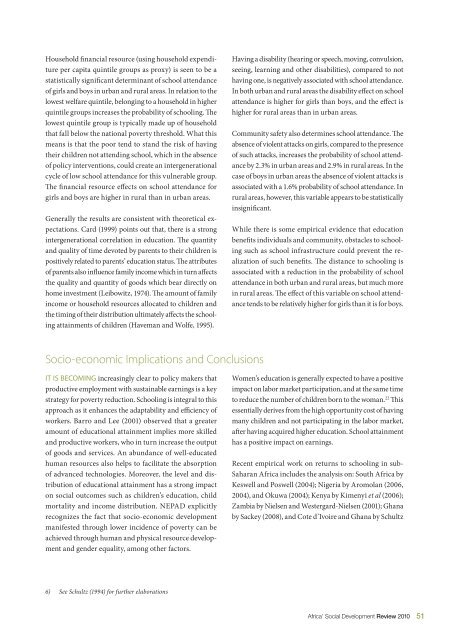The African Social Development Review - United Nations Economic ...
The African Social Development Review - United Nations Economic ...
The African Social Development Review - United Nations Economic ...
Create successful ePaper yourself
Turn your PDF publications into a flip-book with our unique Google optimized e-Paper software.
Household financial resource (using household expenditureper capita quintile groups as proxy) is seen to be astatistically significant determinant of school attendanceof girls and boys in urban and rural areas. In relation to thelowest welfare quintile, belonging to a household in higherquintile groups increases the probability of schooling. <strong>The</strong>lowest quintile group is typically made up of householdthat fall below the national poverty threshold. What thismeans is that the poor tend to stand the risk of havingtheir children not attending school, which in the absenceof policy interventions, could create an intergenerationalcycle of low school attendance for this vulnerable group.<strong>The</strong> financial resource effects on school attendance forgirls and boys are higher in rural than in urban areas.Generally the results are consistent with theoretical expectations.Card (1999) points out that, there is a strongintergenerational correlation in education. <strong>The</strong> quantityand quality of time devoted by parents to their children ispositively related to parents’ education status. <strong>The</strong> attributesof parents also influence family income which in turn affectsthe quality and quantity of goods which bear directly onhome investment (Leibowitz, 1974). <strong>The</strong> amount of familyincome or household resources allocated to children andthe timing of their distribution ultimately affects the schoolingattainments of children (Haveman and Wolfe, 1995).Having a disability (hearing or speech, moving, convulsion,seeing, learning and other disabilities), compared to nothaving one, is negatively associated with school attendance.In both urban and rural areas the disability effect on schoolattendance is higher for girls than boys, and the effect ishigher for rural areas than in urban areas.Community safety also determines school attendance. <strong>The</strong>absence of violent attacks on girls, compared to the presenceof such attacks, increases the probability of school attendanceby 2.3% in urban areas and 2.9% in rural areas. In thecase of boys in urban areas the absence of violent attacks isassociated with a 1.6% probability of school attendance. Inrural areas, however, this variable appears to be statisticallyinsignificant.While there is some empirical evidence that educationbenefits individuals and community, obstacles to schoolingsuch as school infrastructure could prevent the realizationof such benefits. <strong>The</strong> distance to schooling isassociated with a reduction in the probability of schoolattendance in both urban and rural areas, but much morein rural areas. <strong>The</strong> effect of this variable on school attendancetends to be relatively higher for girls than it is for boys.Socio-economic Implications and ConclusionsIT IS BECOMING increasingly clear to policy makers thatproductive employment with sustainable earnings is a keystrategy for poverty reduction. Schooling is integral to thisapproach as it enhances the adaptability and efficiency ofworkers. Barro and Lee (2001) observed that a greateramount of educational attainment implies more skilledand productive workers, who in turn increase the outputof goods and services. An abundance of well-educatedhuman resources also helps to facilitate the absorptionof advanced technologies. Moreover, the level and distributionof educational attainment has a strong impacton social outcomes such as children’s education, childmortality and income distribution. NEPAD explicitlyrecognizes the fact that socio-economic developmentmanifested through lower incidence of poverty can beachieved through human and physical resource developmentand gender equality, among other factors.Women’s education is generally expected to have a positiveimpact on labor market participation, and at the same timeto reduce the number of children born to the woman. 22 Thisessentially derives from the high opportunity cost of havingmany children and not participating in the labor market,after having acquired higher education. School attainmenthas a positive impact on earnings.Recent empirical work on returns to schooling in sub-Saharan Africa includes the analysis on: South Africa byKeswell and Poswell (2004); Nigeria by Aromolan (2006,2004), and Okuwa (2004); Kenya by Kimenyi et al (2006);Zambia by Nielsen and Westergard-Nielsen (2001); Ghanaby Sackey (2008), and Cote d’Ivoire and Ghana by Schultz6) See Schultz (1994) for further elaborationsAfrica’ <strong>Social</strong> <strong>Development</strong> <strong>Review</strong> 201051
















